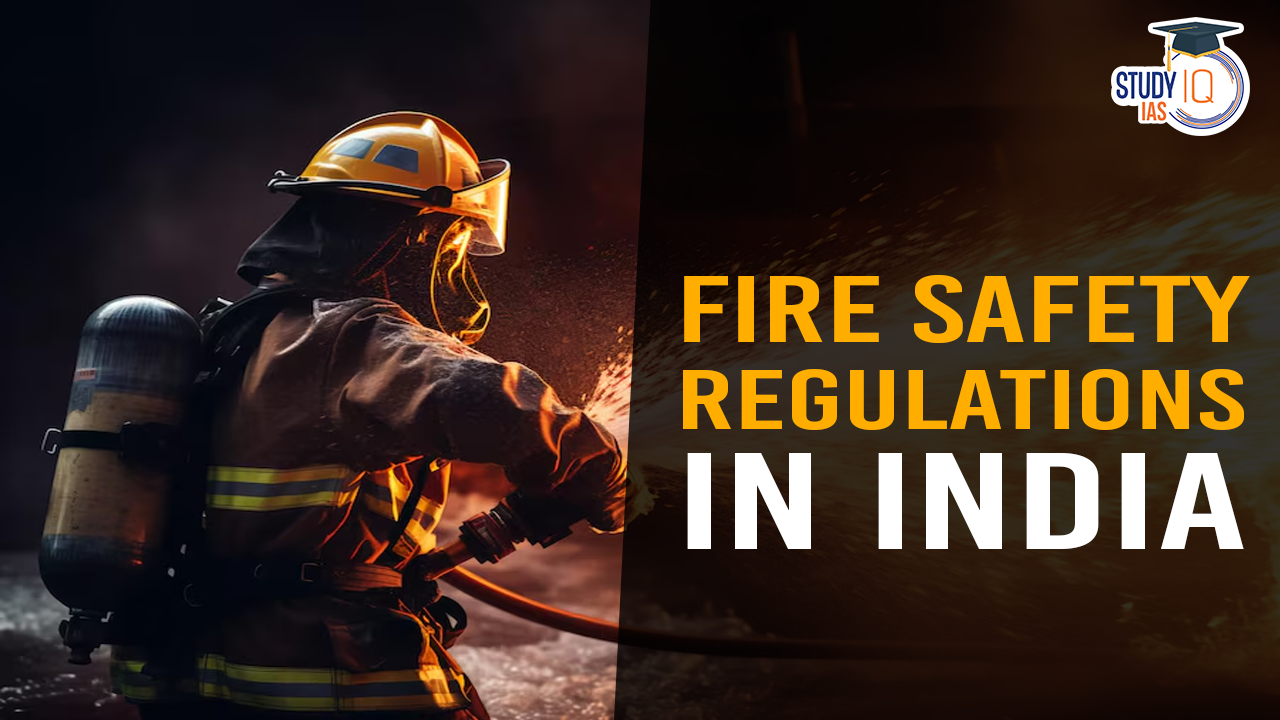Table of Contents
Context: In a tragic event at TRP Game Zone in Rajkot, Gujarat, a fire claimed the lives of at least 32 people, including several children.
Fire Safety Regulations in India
- State Responsibility for Fire Services: Fire service is designated as a state subject and categorised as a municipal function under Article 243(W) in the XII Schedule of the Constitution of India.
- National Building Code (NBC): Originally published in 1970 by the Bureau of Indian Standards (BIS) and updated in 2016, the NBC provides detailed guidelines for the construction, maintenance, and adherence to fire safety protocols in buildings.
- Model Building Bye-Laws 2016: Issued by the Ministry of Housing and Urban Affairs, these laws guide states and Union Territories (UTs) in crafting building bylaws that incorporate fire protection and safety measures.
- National Disaster Management Authority (NDMA) Regulations: NDMA stipulates specific fire safety requirements for public buildings such as hospitals, including provisions for safe spaces, evacuation procedures, and necessary infrastructure like dedicated staircases and regular evacuation drills.
- Local governance: Gujarat’s Comprehensive Development Control Regulations 2017, demands that all buildings, even temporary ones, adhere to the safety standards set by the Fire Authority according to the Fire Prevention and Life Safety Measures Act, 2013.
| Rajkot Gaming Centre Fire |
|
| Delhi Hospital Fire |
|
Legal Precedents and Court Views on Negligence
- Historically significant cases like the Uphaar cinema tragedy in 1997, where 59 people died due to safety violations, have shaped legal precedents.
- The cinema owners were convicted for negligence, and continuous legal battles led to eventual changes in fire safety laws and regulations.
- The Gujarat High Court’s proactive approach in the Rajkot case, where it took suo motu notice, reflects ongoing judicial concern over fire safety enforcement.
- The court’s demands for a government report on compliance with fire safety regulations underline the need for stringent enforcement.
| Facts |
Major Notable Fire Incidents in India:
|
Challenges
- Lack of Urban Planning and Poor Implementation: The National Institute of Disaster Management (NIDM) has identified poor urban planning and implementation as key factors leading to increased fire risks, particularly due to informal settlements and high-density areas.
- Informal Settlements: Many informal settlements develop outside the scope of building bylaws and planning regulations, often ignoring fire safety measures, raising concerns with the growing urban slum population.
- Inadequate Enforcement of Safety Norms: Although the National Building Code (NBC) is intended as a guideline, its critical safety provisions are frequently disregarded locally. Essential certifications are often neglected, and fire safety audits are underused due to local authorities’ failure to conduct regular checks.
- Lack of Monitoring and Compliance: Ineffective inspections and follow-ups by municipal authorities lead to recurring fire incidents, exemplified by a hospital in Delhi and a gaming centre in Rajkot operating without proper licence or safety measures.
- Inadequate Infrastructure: A study by FICCI-Pinkerton reveals that urban India has less than 40% of the needed fire stations. Additionally, materials like polyurethane foam used in construction pose high fire risks due to their flammability and proximity to electrical wiring.
- Lack of Emergency Preparedness: Audits indicate a widespread lack of preparedness across healthcare facilities, many of which lack fire safety clearance, reflecting a systemic indifference to fire safety.
- Non-Uniform Safety Legislation: Since fire services are regulated by state legislation, there is a noticeable lack of standardisation and consistency across different states’ fire safety norms.
Solutions
- Uniform and Robust Legislation: India requires uniform and strong fire safety legislation, complemented by a robust audit mechanism to minimise casualties and ensure safety compliance.
- Strict Adherence to Laws and Regulations: There is a need for stringent adherence to fire prevention guidelines, particularly in older structures, including regular renewal of licences and rigorous inspections.
- Ensuring Proper Compliance: Compliance with building bylaws and planning norms is crucial to prevent disasters and enhance community resilience.
- Effective Response Plans: Municipalities should develop comprehensive fire hazard plans in collaboration with local administration, fire services, and health departments to effectively manage and mitigate fire risks.
- Awareness and Advancement: Public education about fire safety should be integrated into the school curriculum and supplemented with regular drills to prepare children for emergency situations. Modernising fire departments with advanced equipment like smoke detectors and sprinkler systems is also vital.
- Community-Based Fire Risk Management: Communities should regularly conduct awareness programs and actively participate in identifying, analysing, and managing fire risks to reduce vulnerabilities and build capacity.
- Capacity Building: Strengthening communication between civilians in vulnerable areas and fire brigades is essential. Increased government investment in fire safety infrastructure is also necessary.


 New Phase of Operation Chakra to Combat ...
New Phase of Operation Chakra to Combat ...
 Soyuz Aircraft: History, Design and Sign...
Soyuz Aircraft: History, Design and Sign...
 Topological Materials: The Future of Qua...
Topological Materials: The Future of Qua...





















